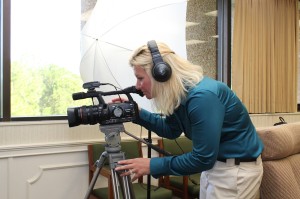Erin Freel with The Market Place was recently interviewed for an article that ran in a Farm Journal Publication. Article below by Ben Potter
 Picture, Perfect.
Picture, Perfect.
Tips on taking better photos and video on your farm
A picture says a thousand words. A video – it’s hard to say exactly, but surely the effect is exponential. Increasingly, farmers are discovering that a beautiful farm photo or video is a great way to get a conversation going. And as they are discovering, you don’t necessarily need to be a seasoned professional to get decent results.
As with any task, a smart first step is defining your purpose and setting goals, according to Doug Armknecht, who has shot multiple harvest videos for his in-laws on their family farm in north central Kansas.
“Do you want to produce pictures or video?” he says. “If pictures, you can do quick snaps with your iPhone that will be sufficient for sharing on social media. Or, if you need better quality for hobby or commercial use, you can invest a little bit in a compact camera, or a lot in a DSLR.”
For video, it comes down to the style of filming you want to do, Armknecht says.
· For point-of-view and wide-angle shots, go with a durable, attachable camera such as a GoPro.
· For professional-looking video with a cinematic feel, you may want a high-end DSLR with HD video capacity.
· For a balanced camera that will do a good job inexpensively, look into consumer-grade compact camcorders. · For quick, casual video, some smartphones can take decent footage.
When you have the right tools for the job, a few “best practices” will give you the best shot at success.
Erin Freel, who owns the professional agricultural communications and marketing company The Market Place, the most valuable best practice is simply practice.
“Practice, practice, practice,” she says. “You can become good at this quickly and learn all the mistakes quickly as well. Everything changes so fast. Find a camera and editing system you are comfortable with and make yourself an expert.”
With that repetition, you should start by getting more footage than you will actually use, Freel says. Take about seven seconds of video for each shot. Don’t zoom or pan, and take a mix of close-up, medium and long shots.
“You will thank yourself later when editing,” she says.
And one more must-follow piece of advice?
“Please, for the love of all things – say no to vertical videos!” Freel says.
Once the raw footage has been collected, take the time to learn some basic editing processes, too, Armknecht recommends.
“Most computers today come with basic photo- and video-editing software built in,” he says. “Taking a few hours to look at some tutorials and educate yourself can really pay off.”
As with taking video, editing video gets easier with practice, he adds. Making more videos and watching other peoples’ videos will help you improve. And teaching yourself basic video cutting and editing techniques can turn a mess of video files into something you’d be proud to share with family and friends, he says.
Even if you’re worried about being tech-savvy enough to become an amateur video producer, chances are you know someone who is up to the task, Armknecht says.
“There’s a good chance that you have family or friends who would be happy to help you get started,” he says. “Photographers and videographers are always looking for interesting subjects to snap or record. My father-in-law does not fly drones or work with video, but I do, and I love to capture harvest and other farm operations for him.”
[WEB EXTRA] Learn more about Doug Armknecht’s experiences shooting harvest videos on his father-in-law’s Kansas operation.
Visit http://www.agweb.com/article/this_wheat_harvest_really_soars_NAA_Ben_Potter/

Erin on location.
Tips on taking better photos and video on your farm
A picture says a thousand words. A video – it’s hard to say exactly, but surely the effect is exponential. Increasingly, farmers are discovering that a beautiful farm photo or video is a great way to get a conversation going. And as they are discovering, you don’t necessarily need to be a seasoned professional to get decent results.
As with any task, a smart first step is defining your purpose and setting goals, according to Doug Armknecht, who has shot multiple harvest videos for his in-laws on their family farm in north central Kansas.
“Do you want to produce pictures or video?” he says. “If pictures, you can do quick snaps with your iPhone that will be sufficient for sharing on social media. Or, if you need better quality for hobby or commercial use, you can invest a little bit in a compact camera, or a lot in a DSLR.”
For video, it comes down to the style of filming you want to do, Armknecht says.
· For point-of-view and wide-angle shots, go with a durable, attachable camera such as a GoPro.
· For professional-looking video with a cinematic feel, you may want a high-end DSLR with HD video capacity.
· For a balanced camera that will do a good job inexpensively, look into consumer-grade compact camcorders. · For quick, casual video, some smartphones can take decent footage.
When you have the right tools for the job, a few “best practices” will give you the best shot at success.
Erin Freel, who owns the professional agricultural communications and marketing company The Market Place, the most valuable best practice is simply practice.
“Practice, practice, practice,” she says. “You can become good at this quickly and learn all the mistakes quickly as well. Everything changes so fast. Find a camera and editing system you are comfortable with and make yourself an expert.”
With that repetition, you should start by getting more footage than you will actually use, Freel says. Take about seven seconds of video for each shot. Don’t zoom or pan, and take a mix of close-up, medium and long shots.
“You will thank yourself later when editing,” she says.
And one more must-follow piece of advice?
“Please, for the love of all things – say no to vertical videos!” Freel says.
Once the raw footage has been collected, take the time to learn some basic editing processes, too, Armknecht recommends.
“Most computers today come with basic photo- and video-editing software built in,” he says. “Taking a few hours to look at some tutorials and educate yourself can really pay off.”
As with taking video, editing video gets easier with practice, he adds. Making more videos and watching other peoples’ videos will help you improve. And teaching yourself basic video cutting and editing techniques can turn a mess of video files into something you’d be proud to share with family and friends, he says.
Even if you’re worried about being tech-savvy enough to become an amateur video producer, chances are you know someone who is up to the task, Armknecht says.
“There’s a good chance that you have family or friends who would be happy to help you get started,” he says. “Photographers and videographers are always looking for interesting subjects to snap or record. My father-in-law does not fly drones or work with video, but I do, and I love to capture harvest and other farm operations for him.”
[WEB EXTRA] Learn more about Doug Armknecht’s experiences shooting harvest videos on his father-in-law’s Kansas operation.
Visit http://www.agweb.com/article/this_wheat_harvest_really_soars_NAA_Ben_Potter/
